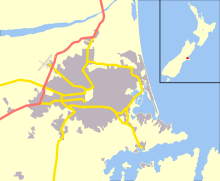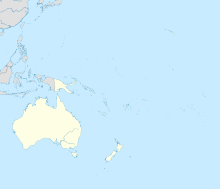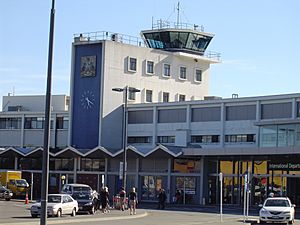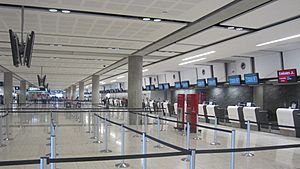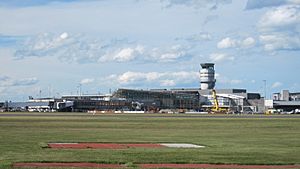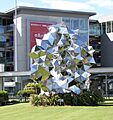Christchurch Airport facts for kids
Quick facts for kids
Christchurch Airport
|
|||||||||||||||||||
|---|---|---|---|---|---|---|---|---|---|---|---|---|---|---|---|---|---|---|---|
 |
|||||||||||||||||||
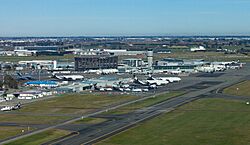
A bird's-eye view of Christchurch Airport in 2020.
|
|||||||||||||||||||
| Summary | |||||||||||||||||||
| Airport type | Public / military | ||||||||||||||||||
| Owner |
|
||||||||||||||||||
| Operator | Christchurch International Airport Limited (CIAL) | ||||||||||||||||||
| Serves | Christchurch | ||||||||||||||||||
| Location | Harewood, Christchurch, New Zealand | ||||||||||||||||||
| Opened | 18 May 1940 | ||||||||||||||||||
| Hub for | Air New Zealand | ||||||||||||||||||
| Time zone | NZST (UTC+12:00) | ||||||||||||||||||
| • Summer (DST) | NZDT (UTC+13:00) | ||||||||||||||||||
| Elevation AMSL | 37 m / 123 ft | ||||||||||||||||||
| Coordinates | 43°29′22″S 172°31′56″E / 43.48944°S 172.53222°E | ||||||||||||||||||
| Map | |||||||||||||||||||
| Runway | |||||||||||||||||||
|
|||||||||||||||||||
| [[Helipad|]] | |||||||||||||||||||
|
|||||||||||||||||||
| Statistics (year to 30 June 2023) | |||||||||||||||||||
|
|||||||||||||||||||
Christchurch Airport (IATA: CHC, ICAO: NZCH) is the main international airport for the city of Christchurch, New Zealand. It is located about 12 kilometres northwest of the city centre in a suburb called Harewood. The airport first opened on 18 May 1940, and on 16 December 1950, it became New Zealand's first airport to handle international flights.
Today, it is the second busiest airport in New Zealand, right after Auckland. It's a key gateway to the South Island for tourists and locals.
Christchurch and Auckland are the only two airports in New Zealand big enough to handle the giant Airbus A380, the world's largest passenger plane. The airport is open 24 hours a day, so planes can take off and land at any time.
Because the wind in Christchurch often blows from different directions, the airport has two main runways built in a cross shape. This allows planes to always take off and land safely into the wind. There is also a smaller grass runway for small planes.
Contents
History of the Airport
In 1935, city leaders decided that Harewood was the best place for a new airport for Christchurch. They bought land in 1936 and built the first runway and a small terminal building. In 1940, it officially opened and was also used by the Royal New Zealand Air Force.
A huge step forward came in 1950 when it became an international airport. This meant people could fly directly to other countries from Christchurch. In 1960, a new, modern terminal building opened to welcome more passengers.
The jet age arrived in 1965 when Qantas started flying Boeing 707 jets to Sydney. To handle even bigger planes, the main runway was made longer. In 1972, the first Boeing 747 "Jumbo Jet" landed in Christchurch, which was a very exciting event.
A Modern Makeover
By the 2000s, the airport was getting very busy and needed a major upgrade. In 2009, work began on a huge project to build a new, modern terminal. The goal was to combine the domestic and international terminals into one large, easy-to-use building.
The project took almost four years. A new check-in hall, shops, and food court opened in 2011. The full project was finished in 2013. The new terminal made the airport much more comfortable and efficient for travellers.
Recent Developments
In December 2023, United Airlines started a direct flight from San Francisco. This was a big deal because it was the first-ever non-stop flight connecting the South Island to North America.
In 2024, the airport's food court got a major renovation with new restaurants and a fresh look. In June 2025, Air New Zealand announced a new direct flight to Adelaide, Australia, which will start in October 2025.
Runways and How They Work
An airport's runways are like its highways for planes. Christchurch Airport has two main runways made of asphalt and a third, smaller one made of grass.
The main runway (02/20) is 3,288 metres long. It is pointed towards the northeast and southwest, which is the direction the wind usually blows. The second runway (11/29) is 1,741 metres long and is used when a strong "Nor'wester" wind blows from the mountains.
Having runways in different directions means that no matter which way the wind is blowing, planes can always land and take off safely. The airport plans to make the runways even longer in the future to handle more flights and larger aircraft.
The Airport Terminal
Christchurch Airport has one large terminal building for all flights, both domestic (within New Zealand) and international (to other countries).
- Ground Floor: This is where you check in for your flight at one of the 58 counters. After you land, you also pick up your checked luggage here in the baggage claim hall.
- First Floor: After you go through security, you'll find the departure lounges. This area has lots of shops, cafes, and restaurants where you can wait for your flight.
The airport has 37 gates where planes park. Some gates use a jetbridge, which is a covered tunnel that connects directly from the terminal to the plane's door, so you don't have to walk outside. Gates for bigger international planes, like the Airbus A380, have special dual jetbridges to help passengers get on and off quickly.
Airlines and Destinations
As of 2025, 11 airlines fly to and from Christchurch, connecting the city to 18 places in New Zealand and 10 cities around the world.
Passenger Flights
| Airlines | Destinations |
|---|---|
| Air Chathams | Chatham Islands |
| Air New Zealand | Auckland, Brisbane, Dunedin, Gold Coast, Hamilton, Hokitika, Invercargill, Melbourne, Napier, Nelson, New Plymouth, Palmerston North, Queenstown, Rotorua, Sydney, Tauranga, Wellington Seasonal: Adelaide (begins 27 October 2025) |
| Cathay Pacific | Seasonal: Hong Kong |
| China Southern Airlines | Seasonal: Guangzhou |
| Emirates | Dubai–International, Sydney |
| Fiji Airways | Nadi |
| Jetstar | Auckland, Cairns, Gold Coast, Melbourne, Wellington |
| Qantas | Brisbane, Melbourne, Sydney |
| Singapore Airlines | Singapore |
| Sounds Air | Blenheim, Wānaka (both end 28 September 2025) |
| United Airlines | Seasonal: San Francisco |
Cargo Flights
Cargo planes carry mail and goods instead of people.
| Airlines | Destinations |
|---|---|
| Airwork | Auckland, Melbourne, Sydney |
| DHL Aviation | Auckland, Melbourne, Sydney |
| FedEx Express | Auckland, Melbourne |
| Parcelair | Auckland, Palmerston North |
| Qantas Freight | Auckland, Melbourne, Sydney |
| Texel Air Australasia | Auckland, Palmerston North |
Special Operations
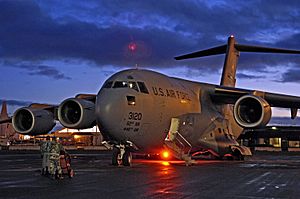
Besides regular passenger flights, Christchurch Airport is used for some very important missions.
Antarctic Missions
Since the 1950s, Christchurch has been the main base for flights to Antarctica. The United States and New Zealand military and science programs, like Operation Deep Freeze, fly from here to their bases on the frozen continent. Large military cargo planes are a common sight at the airport, carrying scientists and supplies.
NASA's Flying Telescope
For many years, a special NASA Boeing 747SP plane called SOFIA used Christchurch as its base. This plane had a giant telescope inside it and would fly high into the atmosphere to study stars and galaxies. Christchurch was chosen because of its long runway and clear skies to the south.
Getting to the Airport
The airport is easy to get to by car, as it is right next to State Highway 1. There are also several public bus routes that connect the airport to the city centre and other suburbs.
Taxis, shuttles, and ride-sharing services like Uber have special areas for picking up and dropping off passengers. There is also a large multi-level car park building for people who want to leave their cars at the airport.
Accidents and Incidents
- On 21 November 1957, a Bristol Freighter cargo plane broke apart in the air and crashed near the airport. Sadly, all four people on board did not survive.
- On 6 June 2003, a small Piper Chieftain plane crashed while trying to land in thick fog. The pilot and seven of the nine passengers died.
- On 8 February 2008, a woman tried to hijack an Eagle Airways flight from Blenheim. The pilots managed to control the situation, and the plane landed safely. The woman was arrested.
- On 31 May 2024, a Jetstar Airbus A320 slid off the side of the runway while landing. No one was hurt, but the airport had to close for a short time.
Images for kids
See also
 In Spanish: Aeropuerto Internacional de Christchurch para niños
In Spanish: Aeropuerto Internacional de Christchurch para niños
- List of airports in New Zealand
- List of airlines of New Zealand
- Transport in New Zealand


